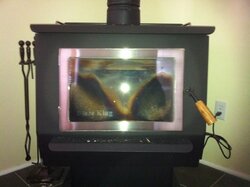Did not want to hijack similar thread since that seems to be different situation.
My question is how to avoid dirty glass as fires burns down. I've been cruising at 450-500 sometimes hotter.
When I let the stove run real hard (650) its a great burn but sooner or later its going to cool some and the glass dirties up some in the corners and along the bottom.
Is this normal? I don't want to run that hard all the time since I don't need that much heat right now and running that hot eats wood I'll want later in the season.
I'm also concered I'm not getting accurate readings w/ the thermo. The other day I let the stove get as hot as I've ever done. The box and glass was super clean but I was afraid I was overfiring. No glowing parts but it is an insert and can't see all parts. I have an IR and temp near flue stack was 500 but stove top thermo (Rutland) was 700+.
Is the Rutland accurate when laid flat or is it trapping heat and reading too hot. Hard to shoot with exactly same place w/ IR due to angle.
My question is how to avoid dirty glass as fires burns down. I've been cruising at 450-500 sometimes hotter.
When I let the stove run real hard (650) its a great burn but sooner or later its going to cool some and the glass dirties up some in the corners and along the bottom.
Is this normal? I don't want to run that hard all the time since I don't need that much heat right now and running that hot eats wood I'll want later in the season.
I'm also concered I'm not getting accurate readings w/ the thermo. The other day I let the stove get as hot as I've ever done. The box and glass was super clean but I was afraid I was overfiring. No glowing parts but it is an insert and can't see all parts. I have an IR and temp near flue stack was 500 but stove top thermo (Rutland) was 700+.
Is the Rutland accurate when laid flat or is it trapping heat and reading too hot. Hard to shoot with exactly same place w/ IR due to angle.


